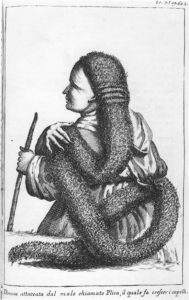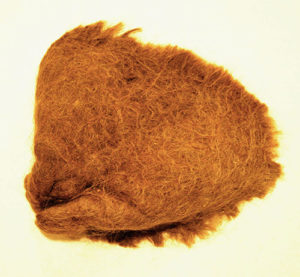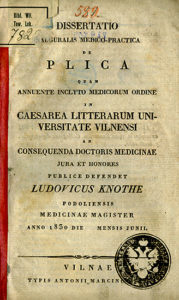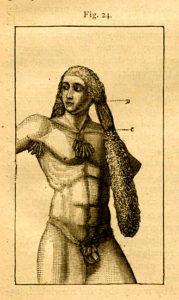By Eglé Sakalauskaité–Juodeikiené, MD, PhD
Plica polonica is an endemic disease of Poland, Tartary, and neighboring countries. It begins with a long-lasting nervous-rheumatic ailment and progresses to the formation of uncombed and filthy hair plaits in hairy parts of the body, especially the head,” wrote Joseph Frank (1771-1842), professor of clinical medicine at Vilnius University, in his textbook Praxeos medicae universae praecepta in 1815.

Eglé Sakalauskaité –Juodeikiené, MD, PhD
Approximately 900 articles, doctoral dissertations, and treatises on plica polonica were published up to the 19th century. Laurentius Starnigelius was probably the first who mentioned the phenomenon of plica polonica in his Epistola ad Academiam Paduanam de plica (Padua, 1599). In the Baroque epoch, various treatises on plica polonica came from Basel (for example, Dissertatio de plica by Michael Gehler, 1601), Paris (Ergo plica epidemica Polonis by M. Jacobus Cousinot, 1606), Venice (Consultatio de plica polonica by Roder a Fonseca, 1618), and other European cities.
During the 18th century, publications on plica were also produced in central European regions that include the city of Erfurt (De plica, s. Judenzopf by Hieronymus Ludolf, 1724), Halle (Dissertatio singularis observationes de plica polonica by Georgius Fridericus Stabel, 1724), Kracow (Tractatus medico – physicus de plica polonica by Joseph Bonfigli, 1720), Vienna (Praktische Abhandlung über den Weichselzopf by Joseph Johann Mastalier, 1790), and many other places. Almost all authors emphasized devastating signs and symptoms of plica such as irreversible plaiting of the hair accompanied by lice, mutilating arthritis, scoliosis, onychogryphosis, and diseases of the nervous system.
Plica polonica (also called Plica Polonica Judaica, Trichoma, Lues Sarmatica in Latin, Kołtki, Goźdźiec, Kołtun in Polish, Kaltūnas in Lithuanian, La Plique Polonaise in French, Weichselzopf, Judenzopf, Hexenzopf in German, and Koлmyњ in Russian) had been thought to be the effect of a spell cast by a witch, suggesting that occurrences of plica were caused by a supernatural influence. Furthermore, plica polonica was also believed to be a punishment from God, and a disease which could not be simply disposed of by cutting off one’s hair, as this would incur serious complications and even a patient’s death.
National Plague
Plica polonica was believed to be associated with a number of pathologies: diseases of the skin, brain, bones, muscles, blood vessels, heart, lungs, and other visceral organs. In the chapter on apoplexy in Joseph Frank’s textbook Praxeos medicae universae praecepta, published in 1818, cutting of plica polonica was stated to be a promotional factor for developing apoplexy. Moreover, plica was believed to destroy the patient, causing ulcerations, inflammation, spasms, seizures, headaches, insomnia, temporary blindness, deafness, and myriad other aches and diseases. This was because the disease was assumed to circulate in the blood and thus exist throughout the body.

Depiction of plica polonica in Lo stato presente di tutti paesi, e popoli del mondo, naturale, politico, e morale by Thomas Salmon, 1739. Public domain.
Plica polonica, called “a national plague, a result of chronic contagions and local conditions,” was discussed as a unique disease in J. Frank’s Mémoires. The disease, according to J. Frank, “is disastrous for the current population; furthermore, it will harm the future generations.” J. Frank assumed that plica involves not only the hair but also other parts of the body: carcinomatous ulcers erode the patient’s skin, bones decay, noses bend, eyes, and ears begin to fear light and sounds, insomnia lasts for months, exacerbating patients’ torments, and “finally, convulsions begin, a patient becomes delirious,” several years pass and death comes, “with rare exceptions” warned the author.
One of J. Frank’s patients was Countess Josephine Przedziacka, a young, gallant, and divorced lady, who arrived in Vilnius and became completely exhausted. “I was sure that it was plica and tried to promote entanglement of the hair (…). Plica was formed and thus her sufferings reduced, and she even gained some weight.” Although the patient was happy about her recovery, she complained of not being able to arrange her hair. “The countess begged me to cut off her plica. I strictly forbade it while the plica had not been fully spread and separated.” However, the countess returned to Minsk, and “one doctor gave her more pleasant advice. The plica was cut off, and the woman soon died.”
In 1804, J. Frank described his other patient Count Joseph Mostowski, whose hypochondria was thought to be caused by plica polonica. The count was “witty, highly educated, a great talker, if he did not talk about his ailments (…), there were medicines around his bed like in a pharmacy.” The count lived near the eastern Prussian border, frequently crossing it to consult local physicians. When Prussian revenue officers became suspicious and searched his carriage, instead of finding contraband, they found containers with pus, which the count kept for the Prussian physicians’ examination.
“This trifle proved that I was faced with the most genuine hypochondriac; moreover, I thought that his brain was affected by the hidden plica” concluded J. Frank.
Multiorgan Disease

Plica polonica. Museum of the History of Lithuanian Medicine and Pharmacy.
Many physicians were interested in the phenomenon of plica polonica. For example, a physician from Volhynia Carolus Kaczkowski (1797-1867) in his Dissertatio inauguralis medico-practica de plicae Polonicae in varias, praeter pilos, corporis humani partes vi et efectu, defended in 1821 in Vilnius University, associated this condition with a number of pathologies: diseases of the skin, bones, tendons, muscles, blood vessels, the heart, lungs, reproductive, and nervous systems. Patients with plica complained of headache, experienced vertigo and epileptic seizures. Syncopes, sleep disorders (insomnia, nightmares), diseases of the spinal cord, and paralysis were also frequently observed, according to the author. Patients complained of hallucinations and experienced melancholy, mania, and hypochondria. Moreover, the “sensation instruments” were also impaired.

The title page of L. Knothe’s doctoral thesis, published in 1830. Vilnius University library, Rare Book department.
Patients with plica suffered from abnormal lacrimation, eye pain, corneal lesions, hypopyon, cataracts, amaurosis, and immobility of the extraocular muscles. Hearing pathology such as tinnitus, auditory hallucinations, smell disorders (mainly due to chronic coryza), and superficial sensation pathology, such as anaesthesia or hypoesthesia of the scalp region, and formication were frequently accompanied by plica polonica, which was thought to be the direct cause of these symptoms.
Another 19th century physician, Ludovicus Knothe from Podolia, was convinced that individuals from certain age groups (maturity, senescence) had higher risk for plica entanglement. Furthermore, patients from some social classes (villagers, beggars) and Jews were believed to have a higher chance of developing plica polonica. Unhealthy environmental conditions (swampy or flooded lands, contact with sulphur vapors and metals) were believed to provoke plica. Sadness, anxiety, resentment, and horror were assumed to predispose patients to plica polonica.
L. Knothe also discussed whether plica was a contagious or congenital disease and disputed plica’s association with syphilis, leprosy, arthritis, and lymphatic system diseases in his Dissertatio inauguralis medico-practica de plica, published and defended in 1830 in Vilnius university.
The treatment of plica polonica was broadly discussed by L. Knothe. “Cleanness is very important: Simple baths or baths with sulphur or potassium [salts] should be recommended,” advised the author. However, “various eye diseases, limb contractures, urinary retention, even madness occur if plica is cut off too early,” he warned.
Various symptoms and concomitant diseases associated with plica should also be cured: “Headaches could be treated with patches of burgundy pitch and condensed jimsonweed juice mixed with moderate amounts of sulphur,” “Pain in extremities should be lessened by taking baths and using an extraction of aconite, sulphur, and antimony.”
L. Knothe noted that mercury preparations are “very efficacious” for treating ulcers, impetigo, chronic inflammations, and nervous diseases related to plica polonica. “Various patches that cause skin blistering, mustard plasters, or ointments in the nuchal region could be applied for the patient.” Finally, mature plica (almost naturally separated from the scalp, when signs of new hair growth are seen) can be cut off without any harm to the patient.
Slow Death of Disease
Another physician Henryk Dobrzycki (1843-1914), a graduate of the Surgical Medical Academy in Warsaw, published a treatise O kołtunie pospolicie, plica polonica” zwanym (“On plait, commonly called plica polonica”) in 1877. H. Dobrzycki performed an analysis of the literature and demonstrated that plica polonica is not a disease, but a result of “obscurity, prejudice, and lack of hygiene.”

Depiction of plica polonica case in H. Dobrzycki‘s tractate, published in 1877. Vilnius University library, Rare Book department.
H. Dobrzycki stated, “Plica polonica is not a disease per se,” furthermore, this “disease” could be found where prejudice, obscurity, and dirtiness flourish.
According to the author, “Civilization and plica polonica cannot coexist.” However, explaining everything to the common folk (that it is only a question of hygiene) is like proving that “the Earth goes around the sun, and not vice versa.” H. Dobrzycki participated in a contest organized by the Vilnius Medical Society and in 1876 received an award for the best treatise on plica polonica. Eventually, the question of whether plica is a disease was finally closed in the Vilnius region.
However, plica polonica was called “a disease of the most remarkable kind, the most prominent and most curious phenomenon,” which “generally begins with the most troublesome symptoms – affections of the head, eyes, skin, etc.” in the textbook The Human Hair: Its Structure, Growth, Diseases, and Their Treatment by the German physician Hermann Beigel (1830-1879), published in London in 1869. Some dermatologists asserted that plica was nothing but eczema capitis with seborrhea and dirt, “but this is not probable,” as it was described in the fifth edition of Essentials of the Principles and Practice of Medicine by Henry Hartshorne (1823-1897), published in 1881 in Philadelphia, Pennsylvania. Moreover, plica polonica was called “the most horrible, incurable” disease, “rendering its victim an object as hideous to behold as the lepers of the East,” that made its appearance in London, “brought over by the traders in false hair from Poland” in the News Items chapter in the 43rd volume of The Saint Louis Medical and Surgical Journal in 1882. Plica polonica was also described as a term “applied to a peculiar matted, felted condition of the hair observed chiefly among Poles” in Practical Dermatology by Bernard Wolff, published in 1906 in Chicago, Illinois. Besides, plica polonica was titled as “the unsightly disease of matted hair” in An Introduction to the History of Medicine by Fielding H. Garrison (1870-1935), published in 1913.
As a contrast, there were some 19th– and 20th– century authors who described plica polonica as a result of the lack of cleanliness combined with pediculosis. “There is good reason to believe that the affection termed plica polonica is nothing more than a combination of filth, lice, and entanglement or felting of the hair,” suggested John Syer Bristowe (1827-1895) in A Treatise on the Theory and Practice of Medicine, published in 1884 in London. Plica polonica was referred to as more “a condition than a disease” in A Practical Treatise on The Diseases of the Hair and Scalp, written by George Thomas Jackson (1852-1916) in 1892 in New York. In the graduation thesis by Francis Eustace Fronczak (1874-1955), awarded by the Medical Department of the University of Buffalo in the United States in 1897, the prognosis of plica was mentioned to be “of the best, inasmuch as it is not a disease.”
Today, we cannot find plica polonica in the International Classification of Diseases (ICD-10), and the phenomenon of plica could be explained by lack of hygiene, pediculosis, and pyoderma in the hairy parts of the body. However, until the end of the 19th century in European cities, plica polonica was believed to be a multiorgan disease, involving the skin and its appendages and associated with a number of chronic diseases, including those of the nervous system.
In many cultures, hair plays an important role in the development of social constructs about the body, and hairstyles convey powerful messages about a person’s beliefs, morality, gender roles, sexual orientation, and even religion, political views, and socio-economic status.
The symbolic power of the human hair could be traced back from Biblical times: Samson, mentioned in the Book of Judges, had superhuman abilities to kill a lion, to slay an entire army, or to destroy a temple with his bare hands; however, after his hair was cut off, Samson’s powers were gone, and he was imprisoned by the Philistines. Cutting one’s hair symbolizes a defeat, humiliation, or punishment.
In Nazi Germany, the government’s social control of Jews included the forced cutting of the hair. Therefore, it is worth remembering that even though hair is a biological phenomenon, it also has social, religious, and personal meanings.•
Eglė Sakalauskaitė–Juodeikienė is a neurologist at the Vilnius University Hospital Santaros klinikos, Lithuania.
Additional Reading:
Sakalauskaitė-Juodeikienė E, Jatužis D, Kaubrys S. Plica Polonica: From National Plague to Death of the Disease in the Nineteenth–Century Vilnius. Indian J Dermatol Venereol Leprol 2018;84: 510-4.
Klajumaitė V. The Phenomenon of Plica Polonica in Lithuania: A Clash of Religious and Scientific Mentalities. Acta Balt Hist Philos Sci 2013;1(2):53–66.
Pergament D. It’s Not Just Hair: Historical and Cultural Considerations for an Emerging Technology. Chic Kent Law Rev 1999;75(1):41–59.
